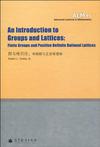群与格引论
2010-5
高等教育出版社
格里斯
251
370000
无
The launch of this Advanced Lectures in Mathematics series is aimed at keeping mathematicians informed of the latest developments in mathematics, as well as to aid in the learning of new mathematical topics by students all over the world.Each volume consists of either an expository monograph or a collection of signifi- cant introductions to important topics. This series emphasizes the history and sources of motivation for the topics under discussion, and also gives an overview of the current status of research in each particular field. These volumes are the first source to which people will turn in order to learn new subjects and to dis- cover the latest results of many cutting-edge fields in mathematics.
1 Introduction 1.1 Outline of the book 1.2 Suggestions for further reading 1.3 Notations, background, conventions2 Bilinear Forms, Quadratic Forms and Their Isometry Groups. 2.1 Standard results on quadratic forms and reflections 2.1.1 Principal ideal domains (PIDs) 2.2 Linear algebra 2.2.1 Interpretation of nonsingularity 2.2.2 Extension of scalars 2.2.3 Cyclicity of the values of a rational bilinea.r form 2.2.4 Gram matrix 2.3 Discriminant group 2.4 Relations between a lattice and sublattices 2.5 Involutions on quadratic spaces 2.6 Standard results on quadratic forms and reflections, II 2.6.1 Involutions on lattices 2.7 Scaled isometries: norm doublers and triplers 3 General Results on Finite Groups and Invariant Lattices 3.1 Discreteness of rational lattices 3.2 Finiteness of the isometry group 3.3 Construction of a G-invariant bilinear form 3.4 Semidirect products and wreath products 3.5 Orthogonal decomposition of lattices4 Root Lattices of Types A, D, E 4.1 Background from Lie theory 4.2 Root lattices, their duals and their isometry groups 4.2.1 Definition of the AN lattices……
Rational lattices occur naturally in many areas of mathematics, such as num-ber theory, geometry, combinatories, representation theory, discrete mathematics,finite groups and Lie theory.The main goal of this book is to explain methods for construction and analysisof positive definite rational lattices and their finite groups of isometries.It seems that many lattices of great interest are related to finite groups andvice versa. One thinks of root lattices, the Barnes-Wall lattices, the Leech latticeand others which occur as sublattices or overlattices of these. The Leech lattice isclosely related to twenty of the twenty-six sporadic simple groups. Many latticeswith relatively high minimum norms have interesting finite isometry groups.Materials in this book are similar to that in graduate courses we gave duringthe 2000s decade at the University of Michigan in Ann Arbor, USA and ZhejiangUniversity in Hangzhou, China. We present group theory and lattice theory asclosely interrelated subjects.Many topics in the theory of lattices and the theory of groups shall be treatedfrom first principles and proofs will be self-contained. Our presentation is moreclassroom style or conversational than encyclopedic. We try to provide clear intro-ductions, give examples and indicate directions. If a full treatment would be longand is otherwise available in publications, we may refer to outside sources.
《群与格引论:有限群与正定有理格(国内英文版)》:An Introduction to Groups and Lattices:Finite Groups and Positive Definite Rational LatticesRational lattices occur throughout mathematics, for example in quadratic forms,sphere packing, Lie theory and integral representations of finite groups. Studies ofhigh-dimensional lattices typically involve number theory, linear algebra, codes,combinatorics and groups. This book presents a basic introduction to rationallattices, finite groups and the deep relationship between these two theories.Dr. Robert L. Griess Jr. is a Professor of Mathematics at the University of Michi-gan and has received various honors including a Guggenheim fellowship, an invitedlecture at the International Congress of Mathematicians, membership in the Ameri-can Academy of Arts and Sciences, and the 2010 AMS Leroy P. Steele Prize for hisseminal construction of the monster group.

无